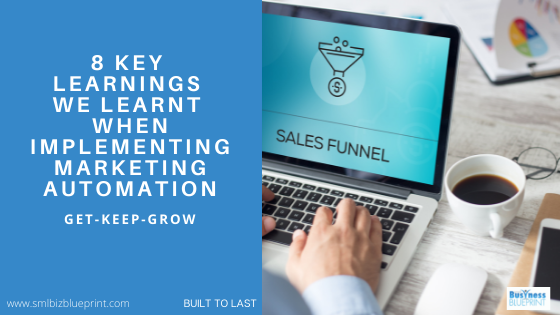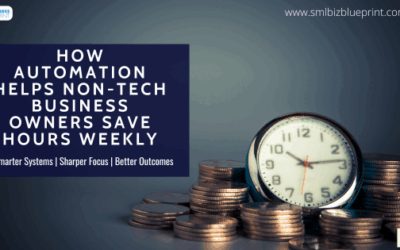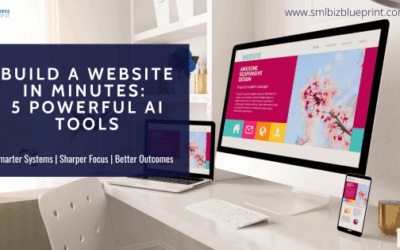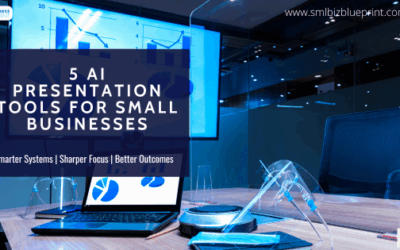Automation is a key component of your business especially if you want to engage and improve your level of service and responsiveness to your customers. But will all things there are some key learnings.

Here are 8 key learnings we have discovered along the way.
1. Automating bad processes doesn’t make your marketing better.
People expect technology to solve their business problems but technology is an accelerant. Technology won’t fix poor processes or problems or workflows.
This might appear like a no-brainer, but it’s the number 1 offense business owners make when implementing automation.
Let’s look at an example.
You have a marketing team that is struggling to supply sales reps with good leads.
In addition, a lot of the work to hand leads to sales is manual, due to a lack of integration with their email provider and CRM .
They target a niche audience in their business market. They email these lists regularly with the goal to schedule more sales appointments, or maybe they will send a newsletter or product offer.
But the company often experiences high bounce rates and low engagement. Their database hasn’t really grown in years, and in fact, it’s churning at a high rate.
They decide it’s time to implement marketing automation to better utilize their existing database and put new lists through automated drip campaigns.
They plan to use lead scoring, as well.
The problem?
The main problem is that this company is solely looking at automation to fix an already broken process. The company needs to fix their lead problem by creating better content, lead magnets and other tactics to generate more leads.
It is a disruptive technology in that it forces a company to think differently about its most important process: revenue creation.
At most companies today, marketing and sales are working from an outdated playbook that was written back when interruptive, batch-and-blast, product-focused, hunch-based marketing actually worked, and Sales was in control of the buying process.
Those days are gone, but the thinking behind that playbook still exists.
Sure, automation can make things easier in some cases and you may even see some short-term gains.
But long-term success is what matters, and that requires a different way of marketing. Using automation as a glorified email tool won’t get you where you need to be.
Great automation is a result of highly targeted, personalized, valuable, timely, and remarkable content that is sent to a healthy and engaged database
The batch-and-blast approach to sending prospects stuff they don’t care about isn’t going to suddenly make things better with automation.
If your company feels like creating great content is the core of your problem, start there.
For this reason we start any automation with mapping out our workflows and setting goals for each stage of any automation.

Photo from Pexels
2 Is the Success of Marketing Automation All about Data?
According to a report, poor data management and quality is the biggest hurdle which is hindering marketers from generating significant ROIs into marketing automation platforms.
The 2016 MarTech Data Report, illustrated both the importance of data management for advanced marketing success, as well as inefficient handling and utilization of data.
The report found that the major problem for 49% of respondents using marketing automation platforms was data hygiene issues, such as data scrubbing and de-duplication.
In addition, 51% reported missing data contributed to data quality, while 55% were of the view that incorrect data was a key contributor to poor quality data.
More than half of the respondents also reported data decay as a critical challenge, and 26% said wrong formats were causing issues.
Overall, data quality and management were the top two marketing technology challenges based on the report.
To compete in today’s data-driven economy, companies must maximize data quality and management.
As marketing runs on data, organizations have started to count on data quality and management as their top priority.
According to the report, marketers are spending most of their time on analytics and reporting, followed by data management, campaign execution, sales support, strategy, and planning.
3 Automation requires a growing and engaged database to nurture.
The average email database expires at the rate of approximately 25% per year. That means a database of 10,000 email addresses will have shrunk to 4,218 in just three years.
The best way to solve for attrition is to replenish the funnel with new leads at a higher rate than you’re burning through. Or else you’ll find yourself with diminishing returns.
Before you invest in marketing automation, ask yourself, “What am I doing to fuel the top of my funnel?”
Automation is a fantastic tool to further qualify and nurture leads, but when you don’t even generate enough for Sales, what’s the point?
Before you implement marketing automation put the processes in place to attract and convert more leads , like creating better content, offers, calls-to-action landing pages and doing things like blogging and optimization
4 Personalization is more relevant than ever
‘Personalization’ it’s the marketing buzzword and with good reason!
Data-driven personalization plays a key role in improving the consumer experience and is becoming more and more expected.
In fact, consumers value personalisation in email marketing so much that 57% of them are willing to swap their data for more personalized marketing experiences now that’s saying something.
It’s clear that personalization is important, but to what extent do you need to personalise your email content?
Personalization doesn’t always have to be on a 1:1 level there are a number of simple ways that you can ensure your email marketing is relevant to your subscribers.
Segmenting your audience based on your parent personas or building data sets based on repeated behaviours can help ensure that you’re sending relevant and more personalised emails to your subscribers.
We’re often sitting on data goldmines, we just don’t know it.

Photo by Mikael Blomkvist from Pexels
5 People don’t exist in a vacuum.
Even if you don’t have a lead generation problem, marketing automation is not the end-all, be-all to demand generation. It’s just the piece of the puzzle.
While it’s a great engine to qualify and score leads, the hard truth is that your leads don’t move perfectly from one campaign to the next.
In reality, your prospects aren’t moving laterally through a branching campaign that you may construct.
Most marketing automation ignores the fact that your leads and contacts aren’t working their way through your campaigns in isolation.
If your marketing is working the way it should be, your leads aren’t just sitting, waiting for your emails — they’re engaging with you through social media, searching for your brand on Google, and finding their way back to your website.
Because most marketing automation campaigns treat your leads as if they exist in a vacuum, your marketing misses several opportunities to interact with prospects and customers when and where they prefer.
Focus on goals for each stage of your marketing automation to achieve best practices.
6 Why will your marketing automation fail?
Because often, there’s no top-of-the-funnel foundation put in place to support middle-of-the-funnel marketing automation.
Marketers won’t have the ingredients they need for effective marketing automation until they have a steady flow of leads.
Too many marketers without inbound lead generation strategies spend their time figuring out how to take the tiny fraction of the market they already have in their database, and squeeze more out of them.
While they’re doing that, their competition is figuring out how to get more out of the 99.99% of the market that’s still out there.
Do you have all the existing leads needed to hit your revenue goals in your database already? Are you getting your fair share of the available market?
Even if your database is currently filled with quality leads, how effective will your marketing automation be when you’ve either converted all those leads into customers, or when your database begins decaying by around 25%/year
Understanding that a large database of leads is required for marketing automation to have any effect on their bottom line, many marketers end up buying lists of contacts to nurture with marketing automation.
This spammy tactic produces incredibly low ROI. Along with the cost of buying these lists, sending unsolicited emails to people who have never requested any information from you leads to low engagement and hurts your IP address reputation, lowering your email deliverability rates.
Don’t invest in marketing automation before you have system for nurturing campaigns to blossom.

7 What does “bad” or “good” marketing automation look like?
Traditional marketing automation often refers to triggering emails based on time delays or actions like email opens and email clicks.
But is an email click alone enough data to execute a personalized lead nurturing strategy?
Marketing automation strategies that offer limited data like this to the marketer often result in bad marketing automation. You need context about who leads are and what they’re interested in to give prospects a good experience.
Marketing automation backed by an inbound strategy is centered around the prospect.
Inbound marketing automation uses all the information we know about a person to inform the automation strategy, so we deliver the information they need to make a purchase, exactly when they need that information, in the place they’re looking for it.
Good marketing automation takes into account the evolving needs of your leads, and the behaviors and interactions they have with you across all of your marketing channels. Not just email.
Using behavioral inputs from multiple channels such as social media, viewing a pricing page, or consuming a particular piece of content gives marketers the context they need to fully understand a lead’s challenges.
The most effective marketing automation also uses those various channels — beyond email — to communicate.
That means the success of your campaign relies less on the email, and fully utilizes the various channels that influence a buyer’s decision.
8 When is the right time to invest in marketing automation?
If you’re publishing good content, generating a steady flow of new, organic leads, and you’re ready to scale your efforts, chances are it’s time to focus your efforts on a marketing automation strategy that will nurture those quality leads into paying customers.
Here are some good questions to ask yourself when deciding if marketing automation is the right move for your business:
- Are you generating a steady flow of new and qualified leads – Has Marketing and Sales agreed on what conversations should happen with marketing and which with sales?
- Do you have a content strategy mapped to your buyer’s journey – Are you tracking your leads’ digital body language across every touch point and marketing channel (not just email)?
- Do you have a proven lead nurturing strategy that you want to scale?
These are all good signs that marketing automation could work for your business.
The key here is understanding that marketing automation does not do marketing for you, but can help scale your successful efforts.
Marketing automation will take your business to another level as long as you have done the groundwork before implementing it totally in your business.




